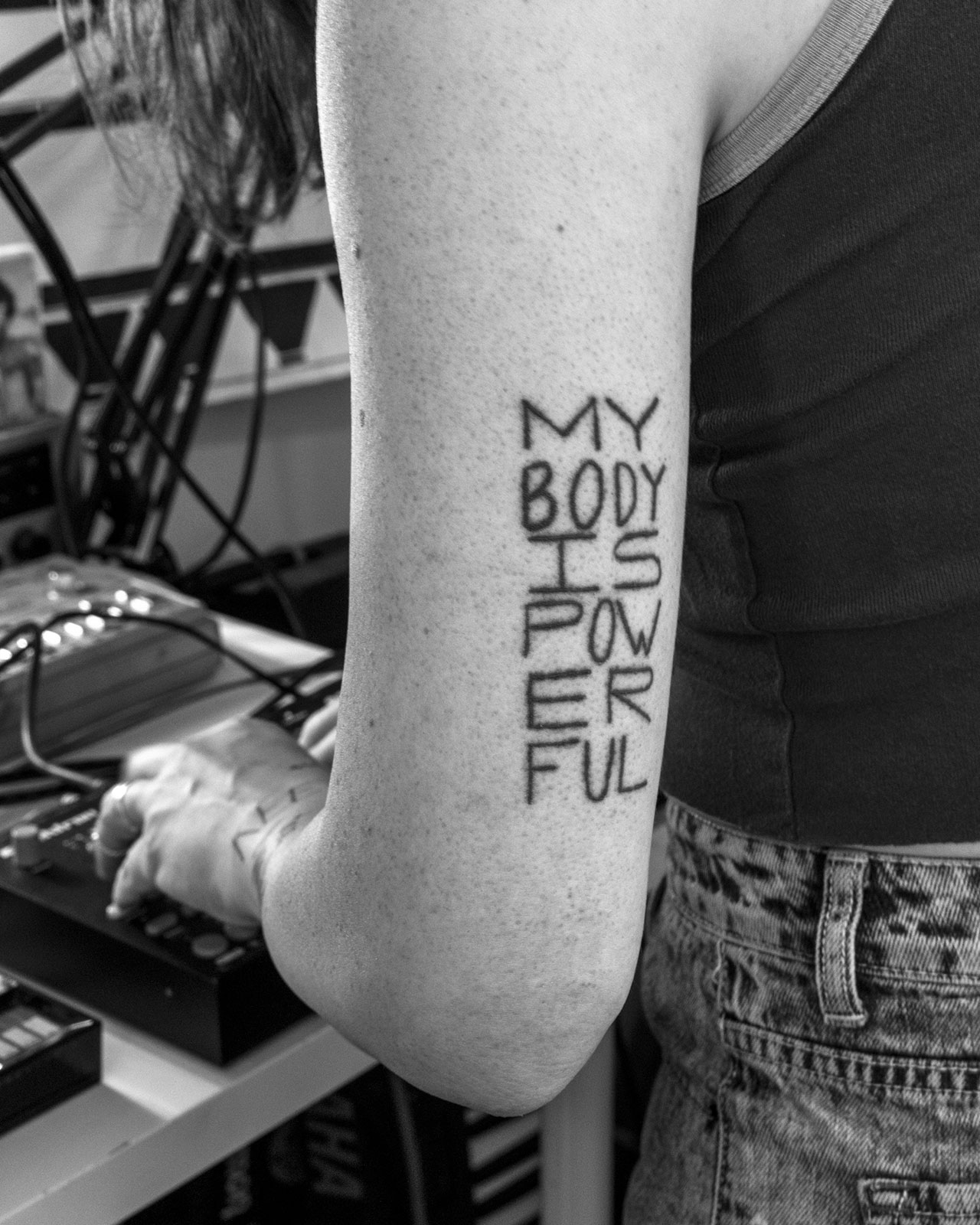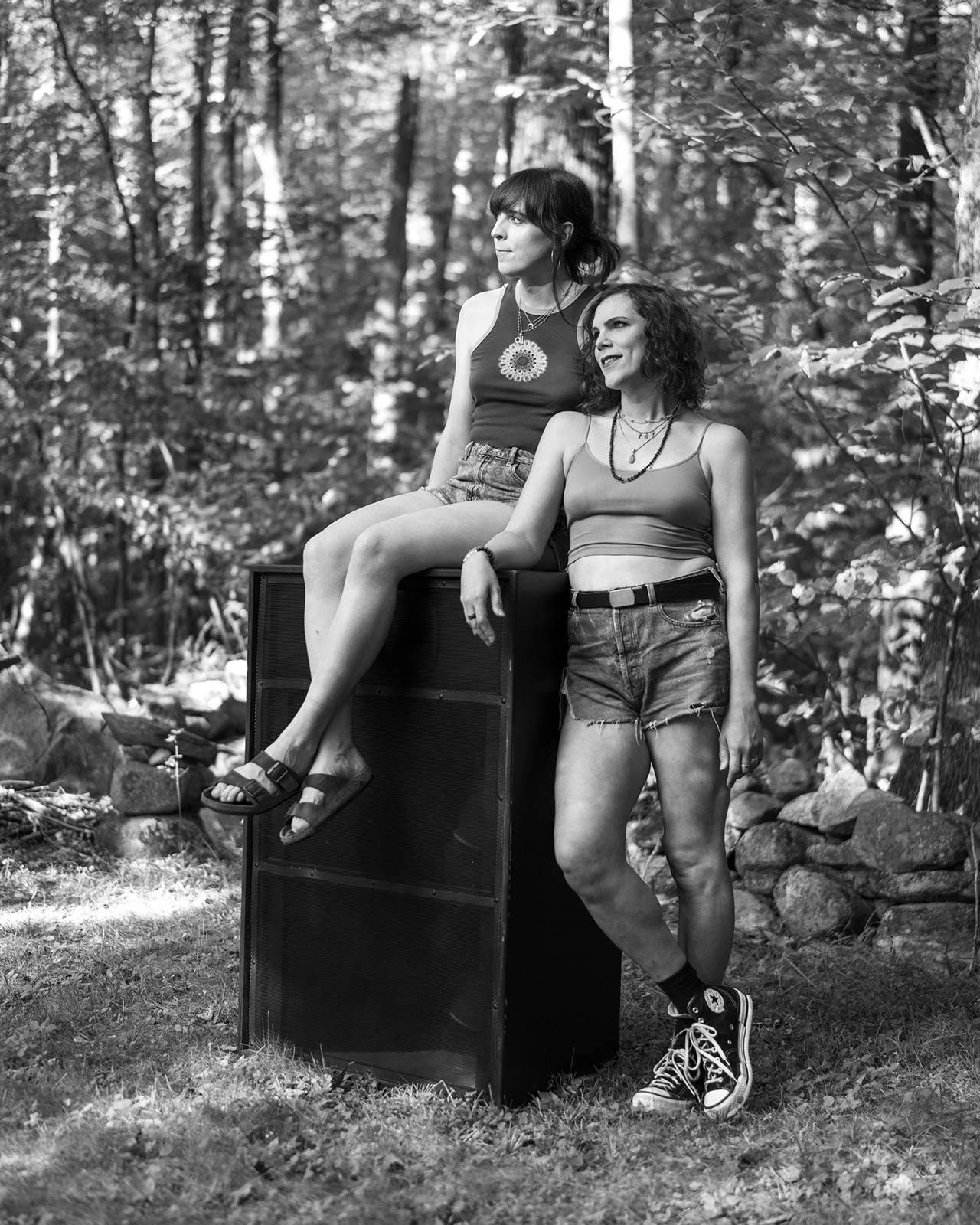
For Document’s Fall/Winter 2023 issue, McKenzie Wark is a houseguest of the dynamic pair, picking their brains on what it is to build a life around music
There are moments when dancing to house music gives you an overwhelming sense of collective joy. It’s a hot day at the end of Pride Month in New York, 2021. We’re under the sun, around the back of the Knockdown Center in Maspeth, Queens. I’m with my roommate Z and her girlfriend E. We’ve knocked ourselves out dancing to techno over the weekend, and we’re here for something like an afters—fatigued and bleary but with pent-up momentum to unwind.
This party is billed as T4T LUV NRG. It’s a back-to-back, where the DJs alternate. In this case, it’s Eris Drew and Octo Octa: two trans women, who both have stellar reputations individually, and who are a delight to experience playing together. Their relation to each other is more than musical—or rather, contains more intimate music. Each plays three tracks in a row, to which the other responds, sometimes with a gentle touch or a kiss.
Everything about it gives the possibility of connection: sensual, emotional, erotic. An affective field radiates over the dance floor, to which dancers bring their own sparkles of joy. E and Z feel it, their queer love finding expression in their dance moves. I’m in a less sunny place. My girlfriend is absent and we are about to break up.
I share some gum with E and Z as we grind our teeth. Some rando comes over, under the pretext of helping himself to the last piece, and touches me in ways I don’t want him to. E, who is not someone to fuck with, puts her body between his and mine. The music plays on. If you let it, it can help you channel all these feelings, both good and bad. Taking care to share the good ones with those around you. Letting the bad ones, the ambivalent ones, and the complicated ones dissipate off into space.
I’ve danced to Eris Drew and Octo Octa since then. At their annual Pride show in 2023, I came with Jenny. We’d just moved in together. Two years after my first time at T4T, I felt the love included me, included us. We didn’t stay long as we’d both injured ourselves at techno raves over the weekend. It was a stretch to get there at all, but it felt like an annual rite to me, from my first time in 2021 when I was going through that breakup, to my second in 2022 during a Tinder date that didn’t pan out, and now, at last, sharing it while in love. It’s music that works for all of those occasions, perhaps because house is about finding joy, whatever the circumstances.
“Out front is a lawn that’s been let to grow wild, thrumming with crickets. It’s not fall yet so they’re still having their own rave.”
Now it’s fall and I’m driving up and down a dirt road on the edge of a New Hampshire town—let’s call it Grover’s Corner—looking for the home of Eris and Octo Octa (whose name in everyday life is Maya). I jumped at the chance to write about them as I love the music they make—separately and together. There aren’t that many trans lesbians in the creative world whose relationships are legible, and I wanted to see that—to see people like me just existing. That’s before we get to more relatable questions about creative, intimate lives that puzzle a good many people. How do any of us do that?
Maya and Eris welcome me into their home. I meet Q, the third (human) member of their household, who doesn’t work in music. Q is to be out of town that night, so their room is free for me to use. I meet John the cat, who is one of those sly, shy ones. Every corner has a little collection of talismans, gathered from the outside world. A vase of fresh flowers stands on the massive wood table, gleaming in the afternoon sun. On one side of the room, an open kitchen; on the other, a wall fronted by big speakers that surround a turntable and a stack of records. This feels like the heart of things: food on one side, music on the other.
Eris and Maya each have their own studio with walls and floors flanked by stacks of vinyl records. In the basement is their sound system, with cabinets the size of washing machines. They sit next to the washing machine itself. This system is a cousin of the one at Nowadays in New York, and a recent acquisition of which they are both charmingly proud. It’s been tested in the backyard, to the consternation of the frogs.
Out front is a lawn that’s been let to grow wild, thrumming with crickets. It’s not fall yet so they’re still having their own rave. Eris tells me that sometimes deer leave their fawns hidden in the grass while they go off to forage. Past the lawn (currently fawn-less) is a rafter of turkeys.
Eris admits the house has been tidied for my arrival. I’m relieved to spot a desk covered in papers. What puts me at ease as a houseguest is just a hint of contained chaos. For creative people in particular, chaos is the source. We’re drawn to it. Later, after we’ve talked for a while, the three of us get into that.
We all had messy passages, trying to figure out how to be close to manic, seething energy without letting it shred us to bits. How to have ongoingness, without losing access to that fire. Learning, sometimes the hard way, that in everyday life some rhythm, some regularity (I won’t call it “order”) is actually what sustains creation and love.
Both Eris and Maya are on the road a lot. The DJ life is a touring life. Together with Q, they’ve made a house that feels like a home, where home is the place where love and flesh come to rest. It was Maya and Q who found this place, who both have New England in them. Eris, from Chicago, came later. A home can adapt, expand, add notes to a chord.
Eris makes the three of us dinner. Simple, healthy, delicious things. Vegan—but we talk about the contradictions in our ethics. About trying to do the right thing in a world built only to do the expedient thing. The metric shit-ton of carbon burned up by touring. I wonder, for a minute, if the size of the forest cut down to print my books would be bigger than the one rustling in the dark beyond the back window.
They’re early-to-bed people, so I try not to keep them up talking, although it’s really a pleasure talking—off the record—about love and life, the chaos of creation, and the beautiful calm of household habits. Maya tells me the local ghost stories. I’m not afraid of ghosts. If they exist, I expect they’re mostly just bored and observing the living. It’s like we’re TV for ghosts. Whatever I’m sensing from the forest out back is another matter entirely. Little by little, humans are cutting down the trees. The suburbs, encroaching.
The next morning is a perfect late summer day. We’re off for a hike. Maya drives. Out on the trail, there’s a difference of opinion on which way to go. Silent, I watch them decide. I feel like Maya is the kind of person who homes in on what is in front of her, while Eris senses what’s all around. They’re both open to the outside in wonderful ways, how they find direction just having different shapes. I’m immediately thinking of how Jenny and I work these little things out, and I wish she was here. I just want to share everything, as you do, when in love.
It rained the day before and we’re finding ghost pipes, and the most spectacular mushrooms. We’re not on mushrooms, but I feel like I am—that sense of being connected and perhaps a little vulnerable. Down by the river, there’s a concave cliff face. Maya suggests I approach it and hear what the river sounds like from there. I’m musically illiterate, so I’m fascinated by this capacity to hear the world. Maya is right; over by the cliff is the river’s dub version.
Like many musicians and ravers, Eris struggles with tinnitus. The rush of running water over rocks gives her some respite. Meanwhile, Maya points out that the glitter all around us on the ground is mica. Later, I’ll look it up and find that one of its uses is in capacitors. I like the thought that the music being made at Grover’s Corner uses this rock. Maya also tells me that this is no old-growth forest. It was all clear-cut to feed the insatiable maw of settler development. It was replanted as a New Deal make-work project. Even here, between the trees, we’re among politics.
Back at the house. Maya and Eris are itching to get in some practice. Maya has a live set coming up and Eris wants some of what she calls “wiggle time” in her studio. I suggest we go on the record over lunch.
Eris: ‘Wiggle time’ is jamming with yourself. I’ll try a unique setup, maybe a pedal array. I write electronic music in sort of a traditional way—in that I love chords. I’ll sit down and try different progressions. Wiggle time can turn into producer time. We’ve been pushing so hard. I just need a few hours before we leave again to explore. We don’t get much downtime. In the winter, we’re going to take off a few months. We’ve never done that before. Although it might not be here. Our house, when we’re here, is a bustle. There’s a lot vying for our attention. And we’re both homebodies.
Maya: I’ve never had a studio outside of where I’m living. Especially when I was in New York—it just wasn’t possible. Moving here was really great—to have more room. But especially when we’re both working on something, there are distractions. Which reminds me, I have laundry to do. Maybe we’ll get space a town over.
Eris: The constant touring has gotten in the way of wiggle time and home time.
Maya: My last EP took three years. Three years for three tracks! I used to produce really quickly. All the touring post-lockdown has been great, but it took away creative time.
Eris: Then we’re home doing label stuff—shipping out records.
McKenzie: So when you’re here, you also have to run a label.
Maya: Two labels.
McKenzie: And do the laundry.
Eris: Something changed in our creative process when we got together, in that both of us had been writing dance tracks for many years, but neither of us had considered ourselves to be engineers. Now we have each other to bounce ideas off. We have such deep respect for each other’s creative process that we can work on the engineering without disrupting that.
Maya: [It’s] having someone who can listen, [who] you can ask, ‘This is bothering me, what should I do?’ And I know she’s not going to say, ‘Well, if the song was any good…’
Eris: This has added a lot of A-and-B time. Listening to the same track in the studio, in the car, on headphones.
Maya: I find things are sounding so much better. I have a hard time playing my own tracks when I DJ. I immediately go into comparison brain. My last record was the first time I was like, Yes! We put in all this time, and it sounds great.
McKenzie: So you are writing music, engineering music, running two labels, practicing for sets, planning and organizing future tours, administering a business or two…
Eris: There’s also prep time. We have to vacuum clean 50 to 60 records before we take them.
Maya: Clubs have fog machines, rave-rain, dust, sweat. All that gunk gets on the record. So we have to clean them all, put the static gun on it. We have to BPM our records, mark them up.
Eris: Maya writes sigils on them too.
Maya: It’s a busy space, but I’ll take it over the jobs I used to have in warehouses, where I’d just be too physically exhausted by the time I got home. We’re busy when we’re here, but I get to be busy with the stuff that really rocks. I like doing most of this stuff.
Eris: A subset of wiggle time is listening time. When we put these speakers by the dining table, [it] was a big change for us. For deep listening to the little details.
Maya: Especially when we get big new stacks of records.
Eris: There’s this constant listening, in part to internalize each other’s records. We also listen to a lot of music we’ll never play in a club, as it’s just so nourishing. Deep listening, as Pauline Oliveros put it. That’s not something you can do on the road.
McKenzie: It’s like the whole household is set up around the filtering and production of music.
Maya: We’ve never had a noise complaint, even when we took the sound system out in the backyard. I grew up listening to music very loud. My ears started getting tired. I’ve had to retrain my brain to listen without the volume.
Eris: I remember the first time I got in your car out here, it was so loud. I wanted to tell her to turn it down, but she was holding my hand.
McKenzie: That’s adorable. One of the background noises I can hear is the insects outside. Or is that my tinnitus?
Eris: We let the front [yard] go full-meadow, and it sounds like dusk insects all the time now. Such a different sound palette.
Maya: In the spring, out back, we have vernal pools. We have spring peepers. Tiny frogs that croak in unison in this alien chorus.
Eris: We have owls, catbirds, baby hawks. My song ‘A Howling Wind’ is all about how it sounds here. I wrote it in the loneliest part of the quarantine. I pitched everything to the wind tone. Doesn’t have a strong tonic, but it has a fundamental frequency.
Maya: The first time I went back there tripping it was like I could perceive the veil, the shimmering sheen—obscuring the things that are beyond.
McKenzie: How do you have a romantic, domestic, sexual, creative partnership, all at once?
Maya: Well, it’s easy to start. There have been times when music is woven so much into our lives that it’s taken up a little too much for me.
Eris: You also need romantic wiggle time.
McKenzie: What’s the division of creative labor?
Eris: For the label, I do most of the writing and Maya does most of the logistics. I do our accounting.
Maya: I do the shipping, as that used to be my day job.
Eris: She’s our web person. We don’t write much music together, so there’s some separate time. We come together as the songs are mostly written and ask: ‘What do you think about that?’ It’s a gentle interaction. We also need our time for romance and quiet dinners and to have deep and intimate sex. Balancing all that is hard, to be honest.
Maya: And we’re in a creative field where there’s this looming sense of, How long will this last? We want to keep going but also want some time for ourselves.
Eris: What if this stops? I love your word ongoingness, from your Raving book. I struggle to deal with the lack of ongoingness. I want this to go on forever. I probably need to shift into a different mode at some point. What could be more fickle than the music industry?
Maya: Or the arts in general.
Eris: The ageism, the shifting sounds, holding your ground in all that. I’m so glad all this is happening when I’m a bit older. I have some perspective.
Maya: You need to focus on enjoying the thing you are doing. I just keep playing music I really, really love.
After I turn the recorder off, Maya and Eris take to their studios—Maya to practice a live set, Eris for wiggle time. I check in on both. Eris shows me her pitch-riding technique. I return to the big table and work on this story while listening to a mix of sounds from both studios, and the crickets outside.
After practice, and after the delicious vegan taco dinner Eris makes, Maya suggests we go out for ice cream. The place a town or two over has plenty of local flavors, and a barn out back with a tableau inside of abandoned dolls. We sit in the cool of dusk, talking about some of the hard stuff in creative relationships. It feels good to share, with other trans women, some of our feelings about the challenges of ongoingness. It’s not often any of us get to talk about this. We’re so few.
It’s a supermoon night—the moon at perigee, big and bold and buttery in the darkening sky. We drive around looking for a good view. Parked by the lake, I try to get a picture of the two of them, lit by it, but it’s not the sort of thing you can photograph. Like love, and like dancing, you can’t really capture what matters most about it. You just have to be there.
Make-up Filipe De Pontes. Production The Morrison Group.
















